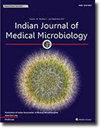Black swimming dots in cell culture: first report of Bradyrhizobium as a cause
IF 1.4
4区 医学
Q4 IMMUNOLOGY
引用次数: 0
Abstract
Introduction
Black swimming dots (BSDs) are a frequent concern for scientists performing cell culture experiments. Despite this, there is very limited literature on this phenomenon. There is one report of Achromobacter species as the causative organism of black swimming dots in cell culture. In this study, we have revealed a 16S ribosomal RNA (bacterial rrs gene) full gene-based confirmation of black swimming dots as Bradyrhizobium species in our cell culture experiments. Bradyrhizobium is primarily a soil-dwelling bacteria, carrying out nitrogen fixation in legume roots.
Methodology
After inoculating the patient blood in L929 cell lines, DNA (deoxyribonucleic acid) isolation was performed on the seventh day from the trypsinized L929 cells. The culture flask under the tissue culture inverted microscope showed small moving dots in the field. The DNA extracted from the infected cell culture was then subjected to conventional PCR (Polymerase Chain Reaction) with the three sets of pan-bacterial primers targeting the full-length 16S ribosomal RNA gene.
Results
Our study reveals the contamination of mammalian cell culture with the black swimming dots caused by Bradyrhizobium species bacteria.
Conclusion
The 16S rRNA full gene analysis revealed that the black swimming dots in our cell culture flasks were due to Bradyrhizobium species. This study further clarifies that the BSDs in cell culture caused due to Bradyrhizobium species could not be cleared by 10 μg/ml concentration of both the antibiotics, piperacillin and ciprofloxacin.

细胞培养中的黑色游泳点:慢生根瘤菌引起的首次报道。
黑色游泳点(bsd)是科学家在进行细胞培养实验时经常关注的问题。尽管如此,关于这一现象的文献非常有限。在细胞培养中发现一种无色杆菌是引起黑游泳点的病原菌。在本研究中,我们在细胞培养实验中揭示了16S核糖体RNA(细菌rrs基因)全基因确认黑游泳点为慢生根瘤菌种。缓生根瘤菌主要是一种居住在土壤中的细菌,在豆科植物的根中进行固氮。方法:将患者血液接种于L929细胞系后,于第7天从胰蛋白酶化的L929细胞中分离DNA(脱氧核糖核酸)。在组织培养倒置显微镜下,培养瓶内出现小的移动点。从感染细胞培养中提取DNA,用三组泛细菌引物对全长16S核糖体RNA基因进行常规PCR(聚合酶链反应)。结果:本研究揭示了缓生根瘤菌对哺乳动物细胞培养物的污染。结论:16S rRNA全基因分析表明,我们的细胞培养瓶中出现的黑色游泳点是由慢生根瘤菌引起的。本研究进一步阐明了10μg/ml浓度的哌拉西林和环丙沙星均不能清除细胞培养中由慢生根瘤菌引起的bsd。
本文章由计算机程序翻译,如有差异,请以英文原文为准。
求助全文
约1分钟内获得全文
求助全文
来源期刊

Indian Journal of Medical Microbiology
IMMUNOLOGY-
CiteScore
2.20
自引率
0.00%
发文量
154
审稿时长
73 days
期刊介绍:
Manuscripts of high standard in the form of original research, multicentric studies, meta analysis, are accepted. Current reports can be submitted as brief communications. Case reports must include review of current literature, clinical details, outcome and follow up. Letters to the editor must be a comment on or pertain to a manuscript already published in the IJMM or in relation to preliminary communication of a larger study.
Review articles, Special Articles or Guest Editorials are accepted on invitation.
 求助内容:
求助内容: 应助结果提醒方式:
应助结果提醒方式:


